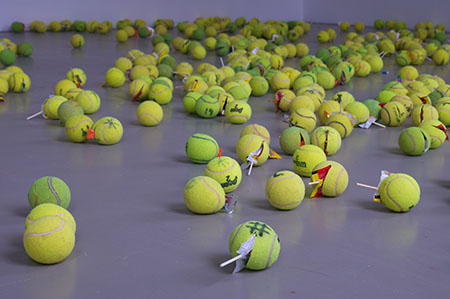Blowback

‘Blowback’ was a term coined by the CIA in the early years of the Cold War. The wall text in the first room of this four-person show quoted Wikipedia’s definition: ‘The espionage term for the violent, unintended consequences of a covert operation that is suffered by the civil population of the aggressor government.’ ‘Blowback’ is a loaded concept: it speaks of a population unaware of high-level clandestine operations and the resulting backlash of pre-determined, state-sponsored moves. At a time when government directives – economic, (un)democratic, even cultural – are resulting in increasingly vocal |responses from citizens, the conceit made for a potent framework.
Unfortunately, the series of works presented were, for the most part, wildly out of step with the heightened rhetoric of the show’s title. Big Mac versus the Honey Monster (2010), by Amsterdam-based artist David Haines, was a bizarre, satirical film that takes place in an abattoir. The soundtrack, sung by the film’s cast, was lifted from an article in the UK’s Daily Express about a worker who had been crushed and badly hurt by one of his colleagues following repeated harassment. Interspersed with indulgent, blood-filled shots and men coolly running their blades along the skins of animals, Haines’s work gestured toward a surreal allegory of warped human nature (with the abattoir functioning as a fittingly morbid setting for this set of disgruntled workers) and the tabloid media’s readiness to popularize and profit from such tales.
As a manifestation of ‘blowback’, it was a strange opening gambit.
The second room contained a more straightforward statement by French collective Claire Fontaine. A large neon sign, Capitalism Kills (Love) (2008), stretched across one wall of the gallery. Using a font called ‘k’, named for Franz Kafka, the piece is described as a tribute to Kafka and his unfinished novel Amerika, which offers a – well, Kafkaesque – portrait of a country the author never actually visited. Unfortunately, the piece was shown opposite a wall of open windows, muting any visual power this spectacular anti-capitalist gesture might have had. Next door, Untitled (Tennis Ball Sculpture) (2009), an installation consisting of tennis balls stuffed with sweets, referenced the way narcotics enter American prisons and function as currency inside penal walls. How these works reveal the repercussions of covert state directives – last I checked, capitalism and prisons aren’t secrets – was unclear. Again, Fontaine’s work felt over-determined by curator Una Henry’s overzealous theme.
The second half of the exhibition raised the stakes with mixed success. Aernout Mik’s video installation Middlemen (2001) is a silent portrait of a trading floor after an economic crash. Shot seven years before Lehman Brothers’ capitulation, Mik’s work is positioned in the press release as an ‘eerie premonition of our current economic situation’. Yet the effect of the economic meltdown in this scenario is confined to a portrait of sweaty, jittering men in Mik’s fictional, paper-strewn set. Within the context of ‘Blowback’, the work’s significance and urgency for today’s context, beyond a shared sense of economic Armageddon, remained unclear.
In the last room, the exhibition finally landed a blow. East Side Story (2006–08) by Croatian artist Igor Gubric´ is a two-channel video installation: on one screen, documentary footage shows neo-Nazi groups attacking marchers during gay pride parades in Belgrade and Zagreb. The work highlights the potent repercussions of introducing cultural liberalism in the nationalist-fuelled context of war-torn states. On the adjacent screen, Gubric´ commissioned street dancers to perform an artistic interpretation of the violence and emotional turmoil of the riots. I first saw this work in WHW’s 2009 Istanbul Biennial ‘What Keeps Mankind Alive?’. There, the Zagreb-based collective placed East Side Story in a rich geographical and political context that bolstered their ambitious polemic. In contrast, the works in ‘Blowback’ felt like an inadequate set of manifestations of what could have been a provocative and timely curatorial proposal.














